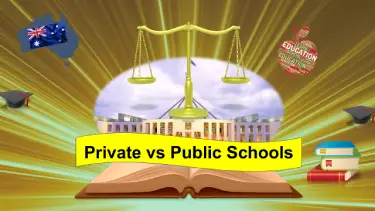Description: Public School Funding
Explore how neoliberalism changes Australian education and why public-school funding should be the government’s priority.
Introduction
Over the past few decades, neoliberalism has drastically altered Australia’s education system, threatened the future of public schools, and widened the gap between the privileged and the disadvantaged. As funding is increasingly diverted to private institutions, public schools are left under-resourced and unable to meet the diverse needs of Australian students. This article examines why public funding must be exclusively given to Australian public schools, ensuring every child has access to free, world-class education.
I. The Rise of Neoliberalism in Australian Education
1. Historical Context
Neoliberalism began influencing Australian policy in the late 20th century, driven by the belief that market-driven solutions would bring efficiency and innovation to public services. This philosophy, rooted in minimal government intervention, soon permeated the education sector. Successive Australian governments, both federal and state, embraced policies that shifted education from a public good to a market commodity, encouraging the growth of private and independent schools at the expense of public education.
2. Privatization and Marketization
In Australia, the neoliberal agenda in education has led to the privatization and marketization of schools. Government policies have increasingly favoured private education providers through substantial funding and incentives. This has created a competitive environment where private schools are seen as superior, leading to a two-tiered education system. The promise was that competition would drive up standards across all schools, but it has deepened inequities and weakened the public school system.
3. Erosion of Public Education Funding
The Australian public school system has suffered from chronic underfunding as resources have been increasingly diverted to private and independent schools. Despite public schools educating most Australian students, especially those from disadvantaged backgrounds, they receive less per-student funding compared to their private counterparts. This funding disparity has led to significant challenges for public schools, including larger class sizes, outdated facilities, and reduced access to essential support services.
II. The Consequences of Neoliberal Policies on Australian Education
1. Widening Inequality
The neoliberal shift towards privatization has worsened educational inequalities in Australia. Public schools, particularly those in rural and low-income areas, struggle with inadequate resources, while private schools’ benefit from generous government funding and added fees paid by affluent families. This inequality is starkly visible in the outcomes, where students from wealthier backgrounds have access to better facilities, more experienced teachers, and a wider range of extracurricular activities.
Supporting Data:
In Australia, the funding model has led to significant disparities. According to reports, some private schools receive more public funding per student than nearby public schools, despite charging substantial tuition fees. This inequity undermines the principle of education as a universal right and reinforces social stratification.
2. Diminished Education Quality
Australian public schools have seen a decline in education quality due to persistent underfunding. Teachers are overburdened with large class sizes, inadequate teaching materials, and insufficient support. The result is a diminished learning experience for students, particularly those in underfunded schools. This situation not only affects academic outcomes but also the overall well-being of students, who miss the broad, holistic education that well-funded schools can provide.
Case Study:
In many Australian public schools, budget constraints have led to the cutting of programs in the arts, sports, and sciences—areas that are critical for a well-rounded education. Conversely, private schools continue to offer extensive programs, further widening the gap between what public and private school students can access.
3. The Commodification of Education
In Australia, neoliberalism has commodified education, transforming it from a public good into a product that can be bought and sold. This is clear in the increasing emphasis on standardized testing, which prioritizes quantifiable outcomes over the development of critical thinking and creativity. Schools are under pressure to produce high test scores to secure funding, leading to a narrowed curriculum and teaching practices that focus on test preparation rather than holistic education.
Implications:
The commodification of education in Australia has significant long-term implications. It not only reduces the quality of education but also deepens social divides, as students in well-resourced schools have greater opportunities to excel in standardized testing environments, while those in underfunded schools are left behind.
III. Advocating for Public School Funding in Australia: A Case for Knowledge Equity
1. Education as a Public Good in Australia
In Australia, education is a fundamental right that should be accessible to all, regardless of socio-economic status. Public education serves as the foundation of Australian democracy, fostering an informed and engaged citizenry. It is essential that the Australian government treats education as a public good, fully funding public schools to ensure every child can succeed.
Argument:
In Australia, the role of public education is to provide a fair and equal start for all children. When the government does not adequately fund public schools, it not only disadvantages those who rely on them but also undermines the broader social fabric. Education should not be contingent on a family’s wealth; it must be a guaranteed right for every Australian child.
2. Government Responsibility in Australia
The Australian government has a critical responsibility to ensure that public schools are fully funded and able to provide a world-class education. Education is an investment in Australia’s future, yielding benefits in the form of a skilled workforce, reduced social inequality, and a more cohesive society. By reallocating resources from private to public education, the government can address the current disparities and work towards a system that serves the needs of all Australian students.
Policy Recommendations:
– Increase Public School Funding: The Australian government must prioritize public education funding, ensuring that every public school has the resources needed to deliver high-quality education.
– Abolish Public Funding for Private Schools: Redirect all public funds currently given to private and independent schools back into the public education system.
– Implement Equitable Funding Models: Develop and adopt funding models that give resources based on the specific needs of schools, ensuring that disadvantaged communities receive the support they need.
3. Case Studies of Success in Australia
 Australia has examples of successful public education systems that show the potential for well-funded schools. Some states and territories have taken steps to increase public school funding, with positive outcomes in student performance and overall school quality. Additionally, countries like Finland offer valuable lessons for Australia, showing that a strong, publicly funded education system can produce world-class results.
Australia has examples of successful public education systems that show the potential for well-funded schools. Some states and territories have taken steps to increase public school funding, with positive outcomes in student performance and overall school quality. Additionally, countries like Finland offer valuable lessons for Australia, showing that a strong, publicly funded education system can produce world-class results.
Key Takeaway:
The success of education systems that prioritize public funding highlights the importance of government commitment to fair education. By following similar principles, Australia can create a system that is both world-class and accessible to all.
IV. Building a World-Class Public Education System in Australia
1. Essential Components of a World-Class Australian Education
To build a world-class public education system in Australia, several key components must be prioritized:
– Curriculum: Develop and support a broad and balanced curriculum that fosters critical thinking, creativity, and problem-solving skills across all subject areas.
– Teaching Quality: Invest in teacher training and professional development to ensure that educators are well-equipped to meet the diverse needs of Australian students.
– Infrastructure: Upgrade and support school facilities, providing modern, safe, and well-equipped learning environments.
– Support Services: Expand access to counselling, special education, and health services to address the holistic needs of students.
Importance of Inclusivity:
Inclusivity is a cornerstone of a world-class education system. Australian schools must be equipped to cater to students from all backgrounds, including those with disabilities, language barriers, or socio-economic challenges. This requires targeted support and resources to ensure that every student can succeed.
2. Policy Recommendations for Australia
To achieve a world-class public education system in Australia, the following policy changes are necessary:
– Increase Investment in Teacher Training: Ensure that all Australian teachers have access to ongoing professional development and are supported in implementing innovative teaching practices.
– Adopt Needs-Based Funding: Allocate resources based on the specific needs of Australian schools, with a focus on those in underserved areas.
– Enhance School Infrastructure: Invest in the construction and maintenance of Australian school facilities, ensuring that all students have access to safe, modern learning environments.
– Expand Support Services: Provide comprehensive support services, including mental health resources, to address the holistic needs of Australian students.
Actionable Steps:
The Australian government must collaborate with educators, parents, and communities to implement these policies. This collaborative approach will ensure that the education system reflects the needs and aspirations of all Australians.
3. Engaging the Australian Public
The movement for fully funded public education in Australia requires broad public support. Citizens must be informed and engaged in advocating for policy changes that prioritize public schools. This can be achieved through:
– Community Outreach: Organize forums and discussions across Australia to raise awareness about the importance of public school funding.
– Grassroots Advocacy: Mobilize Australian parents, teachers, and students to advocate for fair education policies.
– Media Campaigns: Use Australian social media and traditional media to highlight the successes of public schools and the need for increased funding.
Call to Action:
Every Australian has a role to play in ensuring that our public education system receives the funding it needs. By staying informed, engaging in advocacy, and supporting public education initiatives, we can work together to create a system that provides every Australian child with the opportunity to succeed.
V. Conclusion
Reaffirming the Argument
The need for exclusive public funding for public schools in Australia is clear. Neoliberal policies have created a system that prioritizes profit over people, leading to increased inequality and diminished educational outcomes. By committing to fully funding public schools, we can ensure that every Australian child has access to a free, world-class education.
Call to Action
I urge readers to act by supporting Australian public education initiatives, engaging in advocacy efforts, and demanding that the government prioritize funding for public schools. Together, we can create an education system that is fair, inclusive, and world-class.
Future Outlook
The future of Australia depends on the quality of education we provide to our children. By investing in public schools and ensuring they are fully funded, we can build a brighter, more fair future for all Australians.
Summary
Neoliberal policies have undermined public education in Australia, leading to increased inequality and reduced quality. This article argues for exclusive public funding for free, world-class public schools as a solution to these challenges. #EducationReform #PublicSchools #Neoliberalism #Australia
Reader Interaction
What changes do you think are necessary to improve the public education system in Australia? Share your thoughts in the comments below.
Call to Action
If you believe in the importance of fully funded public education in Australia, share this article with your friends and family and join the movement for educational equity.
Social Sharing
Help spread the word about the importance of public-school funding in Australia. Share this article on social media with the hashtags:
#EducationReform, #PublicSchools, #Neoliberalism, #Australia
References
School funding: Private v Public: https://youtu.be/Yj7A2TwplC0
Is Private School Worth the $350,000 Price Tag: https://youtu.be/tUvljHDfNlI
Are private schools better than public schools: https://youtu.be/k4Qmxw-NL4M



Fantastic report. Three cheers to the contributors!
Hi Steven,
Thank you for your feedback. Sharing the article will hopefully bring about a much better outcome for public schools.